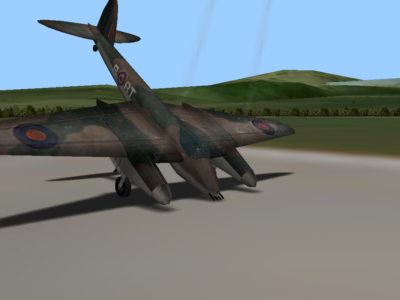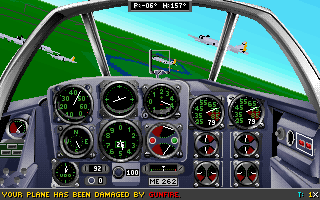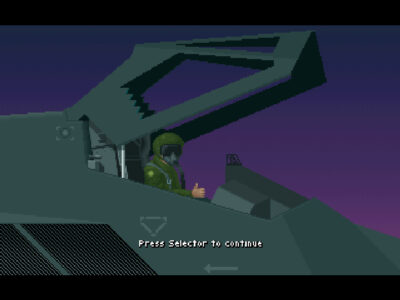A lot of my gaming time in the early 90s was spent on flight sims. It was an offshoot of my childhood interest in aviation. Fighter planes are awesome – they’re fast, they’re loud, they do crazy manoeuvres, they fire machineguns and rockets and make stuff explode. Of course I wanted a chance to sit in the cockpit and fly one myself. Not just by playing some arcade shoot-em-up, but rather a proper simulation that gave me full control of an aircraft.
These can be quite complex games. You have to learn the basics of controlling an aircraft, the three ways the control surfaces can make you turn in the air. There’s a bit of physics to consider; for example there are limits to how quickly you can climb, before your plain stalls and the nose drops. There’s also often a lot of information to take in, looking at little gauges, dials and maybe radar screens. Not to mention lots of buttons to push to make the flaps go down or change some setting on the heads up display.
This meant that flight sims often felt more grownup than other games. They were entertainment, but at the same time, they were Serious Business. That let me feel a bit smug and superior over my gaming peers. Flying a plane was clearly a more worthwhile pursuit than Mario jumping on turtles. I could tell myself (and almost believe) that I was fine with the beige family PC, and had no desire to own a console. This was to some extent a lie born of jealousy, and really I wished I could play Super Mario World as well as my sims. Still, my enthusiasm for the genre was very genuine.
I played plenty of historical sims, such as the Aces series from Dynamix. I relished the chance to take place in second world war dogfights, piloting the sort of classic aircraft I voraciously read books about. Sat in front of the PC I could pretend I was an old fashioned fighter ace, a champion in the fight against the luftwaffe. Swooping and diving through the skies I would shoot down countless Me-109s, strafe airfields and gallantly defend fleets of bombers.
I also liked a few sims in contemporary settings. Or I suppose what was then contemporary. These were the days of Desert storm, so the middle east was a commonly featured warzone. The technology was still that of the last days of the cold war – The F-15 was still king of the skies, the F22 a mere prototype. Stealth fighters were a marvellous new technology, like something out of a Tom Clancy novel. The US Navy still had intruders and Vikings, the RAF had the famous Harrier.
However, for all the time I spent on these games I never claimed to be particularly good at flight sims. I’d often set the flight models to more simple versions, particularly in helicopter sims which are a whole other level of complexity. I also tended to ignore entire sections of the game such as campaign modes with resource management and command of entire squadrons, which seemed far too much like hard work and staring at map screens.
Then there’s landing. I dreaded landing, which is all about dealing with the ultimate threat to an aircraft, solid ground. I suppose it’s not exactly super difficult if you practise enough, it’s just a tedious way to end a mission, a chore that requires several minutes of concentration. I don’t really my past hour’s successes to be thrown away in a fireball and a crater just because I got impatient and made too steep a descent. Most sims offered an option to just fly back to friendly skies and hit an “end mission” command, and that’s what I usually used. Yet it always felt a bit unsatisfying, like I was cheating.
As time went by, I started to drift away from a genre that was once a favourite. I think TFX did a lot to kill my interest in new sims. It looked amazing, especially with its “cinematic flyby” view mode with your Eurofighter blasting past the camera, but I didn’t have the first clue how to actually do anything apart from spin around the sky firing missles randomly. Looking back, I see people describe it as “arcadey”, which is profoundly depressing and doesn’t say much for my sim expertise.
I continued to enjoy space-sims like Freespace for a while, and that’s material for another article, another day. Sadly though the will to play real-world flight sims diminished. Perhaps there was a sense that they were now all too complicated. Flight models became ever more realistic, in other words unforgiving. Get too crazy with your manoeuvres and whoops, looks like you’re in a spin towards the ground. Controls became more extensive and elaborate, which means flipping twelve different switches trying to turn the radar on, then not understanding anything it’s telling you anyway.
Once sims had made me feel superior to other kids still playing juvenile stuff like Sonic the Hedgehog. Now my pretense at being a more elite and refined gamer was revealed to be a sham. I actually had neither the skills nor the patience to persevere with any serious sims.
By the 2000s, I’d pretty much stopped playing. I did at one point, 7 or so years ago, try to rekindle my interest by grabbing Janes USAF from my local GAME (these being the days when it had a PC section worth speaking of). I then failed the very first training mission, by crashing into another plane while taxiing to the runway. Oh and I once tried a game called Aces High:

I, uh… yeah. I can’t really explain that one.
I suppose I could go back to the genre. I could just put in some effort, do lots of training missions, read advice on reddit. Nowadays though I have less free time, and that puts me off games with steep learning curves. I don’t want to have to watch youtube videos, just to understand how to fire a missile. The prospect of doing hours of homework to get to grips with a game is neither entertainment, nor a productive use of time.
As well as giving up on flight sims, I’ve never even written much here about those ones that I played back in my youth. I guess I never felt competent enough to give a properly informed overview. Furthermore, I have little knowledge of the modern state of the genre to give any sort of frame of reference for the oldies. Still, I thought I might free myself from the need to provide any sort of objective review, and share some of my experiences of playing them.
Lucasarts sims
This trilogy of World War 2 sims ran from 1988 to 1991. Each featured a different theatre of the war, and let you fly for both sides. I missed the first one, Battlehawks 1942, based on the war in the Pacific. However, the next entry, Their Finest Hour: The Battle Of Britain was my first real flight sim. In fact it was one of the first major commercial games of any sort that I played, on our family 386 (after years of playing shareware and early 80s relics on our old amstrad 1512).
This was where I learned the fundamentals of flight, along with basic skills for combat such as deflection shooting to hit a moving target. I spent many hours patriotically shooting down Messercshmits and Heinkels over the English Channel. Stukas were the easiest target – despite their fearsome reputation as dive bombers, they were fairly defenseless against fighter planes.
Even though two decades on the 5.25″ disks within are useless to me, I’ve still got the packaging, as it was real big-box luxury. For a start you had the extensive manual, which was obligatory for a sim. Also though there was a newsletter from Lucasarts, and the box art was an actual painting! It makes the later days of DVD-style cases look a bit sad.
Secret Weapons of the Luftwaffe meanwhile, was set during USAF’s bombing campaign over western europe in the latter half of the war. The title refers to advanced nazi planes that used jet and rocket propulsion, which at the time were brand new technologies. Their goal was to challenge allied air superiority and break the bomber formations that were battering the third reich.

You know, I loaded Swotl up for the first time in two decades just to take a picture or two, and immediately recognised the thumping of heavy 30mm cannons.
There was certainly a thrill in piloting the worlds first fighter jet, hurtling past helpless plodding american fighters. This was followed by a sense of relief, that the Secret weapons were too few and too late to make a difference. If the Luftwaffe had possessed more of them, they could have devastated the USAF and RAF.
As well as flying fighters, both of these games let you take control of medium and heavy bombers. That had a certain novelty, as you could take control of any of the defensive gun turrets – the B17 in Swotl had 6 of them. However, I never had a clue how to actually successfully bomb something. You’re at several kilometers up and this is well before the age of guided munitions. So you try and line up the target through some sort of primitive sighting device, open a hatch and then just drop a few tons of high explosives. Good luck with that!
Microprose Sims
The stable of flight sims from Microprose was once one of the mainstays of PC gaming. Looking back, I think they somehow struck an ideal balance between realism, and accessibility. They weren’t arcadey shoot-em-ups, and certainly felt authentic. Yet also they weren’t ridiculously complicated or totally unforgiving. Reading the 200 page manual was highly recommended, but not absolutely essential just to get off the ground. If there were sims out like that today, I might just be tempted back.
I played a great deal of two of these. In F117 Stealth Fighter 2.0, I was creeping around the night skies bombing Libyan shoe factories. Or, er, hopefully something more military in nature. Stealth certainly played a major part in your operations, with gauges to show how close enemy radar was to spotting you, so you had to either pick your way around missile sites, or risk fighting your way past them. What I wasn’t doing much of was landing. I think I only ever managed a couple.

Also there was Gunship 2000, which was all about thundering around at treetop height blowing up soviet tanks. It gave you wide range of American helicopters, although I never really saw the point in dinky little scouts and always took the heavily armed Apache Gunship. I also had to play with the controls set to easy mode, which basically means the “go forward or backwards” control doesn’t affect your altitude.
Chuck Yeager’s Air Combat
“It’s a great day for flying” said Chuck’s tinny digitised voice when you loaded this up. He would also chastise you for screwing up a mission. Nowadays Dosbox’s soundblaster emulation goes all screwy and distorts the speech clips, so he just mutters some kind of garbled demonic curse.

This sim’s main selling point, aside from the celebrity endorsement, was that it spanned the three major conflicts during which Yeager served. Each of these saw a new generation of fighter aircraft. First up you have the second world war, which was all about propellers and machine-guns. Next is Korea, one of the first major conflicts where jet planes were commonly used. So everything is going about 200mph faster. Then you have Vietnam, where the planes are even speedier, but also now carrying radar and guided missiles.
The game had plenty of historically based missions, but also a custom mission builder that let you freely mix up all the available aircraft from the three eras. So of course I’d gleefully, and rather unsportingly, go chasing second world war bombers with technology two decades more advanced.



 Posts
Posts
I never really got into flight Sims, the only ones I had were Strike Force Harrier and Red Barron. I keep thinking I would like to try more, but I don’t even have the time to learn the controls these days.
I have turned into a modern gamer somewhere along the way. I expect everything to be obvious and not complicated. Saying that though , a VR flight sim on one of these new VR devices would be special. It seems to be mostly shooty and zombie games at the moment. I think if it was this technology in the early nineties, it would be either flight Sims or an RPG leading the way with this tech. VR Eye Of The Beholder, yes please. Or hunter.
How would lemmings work? Or the cheat code in shadow of the beast ii, ten pints, you have to really drink ten pints? Sounds like binge drinking to me, or a Friday night.
Sorry, went of at a tangent somewhere and lost the track of my comment.
March 20, 2016 @ 10:07 pm
Flight sims do seem a fairly obvious choice for VR!
VR lemmings sounds fun though. Or possibly a harrowing experience as your lemming buddies get flattened by pistons around you then you plummet to your death off a cliff.
March 23, 2016 @ 10:09 pm
I know this comment is coming 7 years late but um, I just wanted to say that you can get kind of close to this experience in /3D Lemmings/ from the mid-’90s. You can see in first person from the perspective of any one of the alive lemmings on the field in that game, and it is very much as you describe. Amusingly it’s an essential feature, also, since some stages have sections that are difficult or impossible to see with the normal camera.
May 20, 2023 @ 10:10 pm
I tried lemmings 3D, didn’t get on well with the controls. Still it’s from an interesting period in gaming, where everyone was trying to go 3D with varying levels of success.
May 31, 2023 @ 12:11 pm